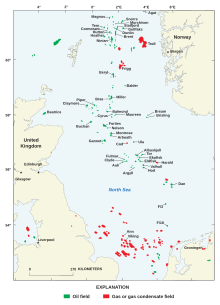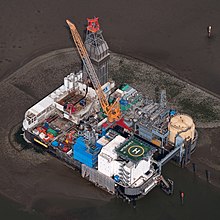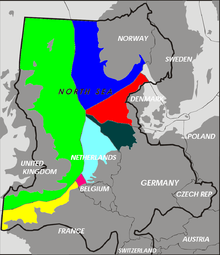
The Mumbai High Field, formerly called the Bombay High Field, is an offshore oilfield 176 km (109 mi) off the west coast of Mumbai, in Gulf of Cambay region of India, in about 75 m (246 ft) of water. The oil operations are run by India's Oil and Natural Gas Corporation (ONGC).

Snøhvit(English: Snow White) is the name of a natural gas field in the Norwegian Sea, situated 140 kilometres (87 mi) northwest of Hammerfest, Norway. The northern part of the Norwegian Sea is often described as the Barents Sea by offshore petroleum companies. Snøhvit is also the name of a development of Snøhvit and the two neighbouring natural gas fields Albatross and Askeladden. Estimated recoverable reserves are 193 billion cubic metres of natural gas, 113 million barrels of condensate, and 5.1 million tonnes of natural gas liquids (NGL). The development comprises 21 wells. The Snøhvit development is operated by Equinor on behalf of six gas companies owning licenses:

Hibernia is an oil field in the North Atlantic Ocean, approximately 315 kilometres (196 mi) east-southeast of St. John's, Newfoundland, Canada, in 80 m of water.

Ouargla or Warqla is a province (wilaya) in eastern Algeria. Its capital is Ouargla. Other localities include Hassi Ben Abdellah and Hassi Messaoud. It borders Ouled Djellal Province, El M'Ghair Province Touggourt Province, and El Oued Province to the north, Tunisia to the east, In Salah Province and Illizi Province to the south, and El Menia Province, Ghardaia Province and Djelfa Province to the west. It contains the Issaouane Erg desert.

Ekofisk is an oil field in block 2/4 of the Norwegian sector of the North Sea about 320 km (200 mi) southwest of Stavanger. Discovered in 1969 by Phillips Petroleum Company, it remains one of the most important oil fields in the North Sea. This was the first discovery of oil after the drilling of over 200 exploration wells in the North Sea "triggered" by the Groningen gas field discovery. In 1971, Phillips started producing directly to tankers from four subsea wells. Oil production is planned to continue until at least 2050.

The Statfjord oil field is a large oil and gas field covering 580 km2 in the U.K.-Norwegian boundary of the North Sea at a water depth of 145 m, discovered in 1974 by Mobil and since 1987 operated by Equinor.

Gullfaks is an oil and gas field in the Norwegian sector of the North Sea operated by Equinor. It was discovered in 1978, in block 34/10, at a water depth of 130-230 meters. The initial recoverable reserve is 2.1 billion barrels, and the remaining recoverable reserve in 2004 is 234 million barrels. This oil field reached peak production in 2001 at 180,000 barrels per day (29,000 m3/d). It has satellite fields Gullfaks South, Rimfaks, Skinfaks and Gullveig.

Troll is a natural gas and oil field in the Norwegian sector of the North Sea, one of the biggest in the North Sea, holding 40% of Norway’s gas – it also possesses significant quantities of oil, in thin zones under the gas cap, to the west of the field. The field as a whole consists of the main Troll East and Troll West structures in blocks 31/2, 31/3, 31/5 and 31/6, about 65 kilometres (40 mi) west of Kollsnes, near Bergen. Most of the gas lies in Troll East.

The Piper oilfield is a substantial North Sea oilfield covering 30.1 km2. It lies roughly halfway between Aberdeen and Bergen, at the eastern end of the Moray Firth basin. Oil extracted from it is piped to Scotland, where it is stabilised at an oil plant on the island of Flotta, in the Orkney archipelago, while gas is shipped via the Frigg gas pipeline. In June 1975, the Piper Alpha oil platform was placed over the field in 144 metres of water, secured in place by 24 piles extending 116 metres beneath the seabed. The platform was designed for simultaneous drilling and production. Piper Alpha was the site of one of the world's worst oil platform disasters when it was destroyed by an explosion in 1988, with the loss of 167 lives. Piper Bravo was installed in 1992. Talisman Energy acquired a controlling interest in 2000.
The Sable Offshore Energy Project (SOEP) is a consortium based in Halifax, Nova Scotia which explores for and produced natural gas near Sable Island on the edge of the Nova Scotian continental shelf in eastern Canada. SOEP produced between 400 and 500 million cubic feet (14,000,000 m3) of natural gas and 20,000 barrels (3,200 m3) of natural gas liquids daily until 2018.
Eugene Island block 330 oil field is an oil field in the United States Exclusive Economic Zone in the Gulf of Mexico. It is located 170 miles (270 km) southwest of New Orleans, 70–85 miles (113–137 km) off the Louisiana coast comprising six and a half leased blocks: Eugene Island 313, 314 south, 330, 331, 332, 337 and 338.

The Forties Oil Field is the second largest oil field in the North Sea, after the Clair oilfield, which is located 110 miles east of Aberdeen. It was discovered in 1970 and first produced oil in 1975 under ownership of British Petroleum, now called BP.

The Sirte Basin is a late Mesozoic and Cenozoic triple junction continental rift along northern Africa that was initiated during the late Jurassic Period. It borders a relatively stable Paleozoic craton and cratonic sag basins along its southern margins. The province extends offshore into the Mediterranean Sea, with the northern boundary drawn at the 2,000 meter (m) bathymetric contour. It borders in the north on the Gulf of Sidra and extends south into northern Chad.

Draugen is an oil field in the Norwegian Sea with a sea depth of 250 metres (800 ft). It has been operating by A/S Norske Shell until sold to AS OKEA in 2018. The field has been developed with a concrete fixed facility and integrated topside. Stabilized oil is stored in tanks in the base of the facility. Two flowlines connect the facility to a floating loading buoy.

Frigg gas field is a natural gas field on Norwegian block 25/1 in the North Sea, on the boundary between the United Kingdom and Norway. The field is named after the goddess Frigg. King Olav V of Norway officially opened production on 8 May 1978. Production was closed on 26 October 2004. The field is situated 230 kilometres (140 mi) northwest of Stavanger. Operator for the field was the French oil company Elf Aquitaine, which merged and changed name to Total S.A.
The Miller oilfield is a deep reservoir under the North Sea, 240 kilometres north-east of Peterhead in UKCS Blocks 16/7b and 16/8b. It was discovered in 1983 by BP in a water depth of 100 metres. Production from Miller field started in June 1992, and plateau production was from late 1992 to 1997 at rates of up to 150,000 barrels (24,000 m3) of oil and 255 million cu ft (7.2 million m3) of gas per day at standard conditions. Miller produced some 345 million barrels (54,900,000 m3) of oil during its lifetime. The field is named after Hugh Miller who contributed to Scottish geology in the early nineteenth century.

The Bohai Sea is a gulf/inland sea approximately 77,000 km2 (30,000 sq mi) in area on the east coast of Mainland China. It is the northwestern and innermost extension of the Yellow Sea, to which it connects to the east via the Bohai Strait. It has a mean depth of approximately 18 meters (59 ft), with a maximum depth of about 80 meters (260 ft) located in the northern part of the Bohai Strait.
The Albacora-Leste Oil Field is an oil field located in Campos Basin. It was discovered in 1986 and developed by Petrobras. The oil field is operated by Petrobras, that owns 90% of the field, while Repsol owns the remaining 10%. The total proven reserves of the Albacora-Leste oil field are around 534 million barrels (72×106tonnes), and production is centered on 180,000 barrels per day (29,000 m3/d). In April 2022, Petro Rio (through its subsidiary Petro Rio Jaguar Petróleo), acquired a 90% operating stake in the Albacora Leste field Petróleo Brasileiro (Petrobras) for $2.2bn USD.
In addition to terrestrial oil wells, Canada also extracts oil via offshore drilling.
Rosetti Marino SpA is the parent company of an industrial group, listed in the Milan stock exchange of AIM Italia Mercato alternativo del capitale and comprising 18 companies, 9 branch offices and 1,200 employees.














